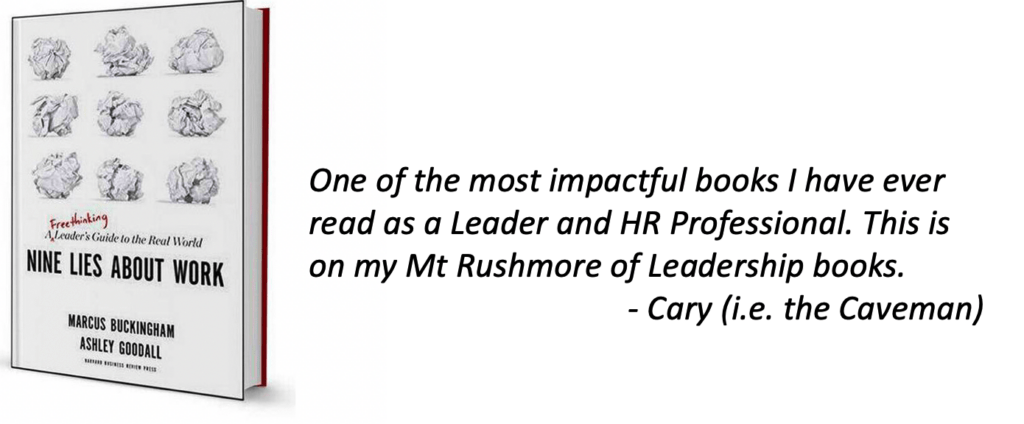Stop Cascading Goals & Start Cascading Purpose (Nine Lies – Lie #3)
Pick your poison:
- Management by Objectives (from Peter Drucker)
- SMART goals (Specific, Measurable, Actionable, Reasonable, & Time-bound)
- KPIs (Key Performance Indicators)
- BHAGs (Big Hairy audacious Goals from Jim Collins)
- OKRs (Objective & Key Results)
No matter what company you work for, most likely you are using one of the above methodologies to set performance goals across your organization. These methodologies are designed to help translate the strategic priorities set by senior leaders into tangible actions that the frontline will accomplish. It reminds me very much of the military. The generals set a goal, and then that goal is split up and cascaded to the rest of the soldiers.
I understand why cascading goals is a part of every company’s performance management process. Since the goals are cascaded straight from the top, it reassures senior leaders that everyone is working on the “right” things. I mean imagine if the generals (or your company’s senior leaders) didn’t cascade goals. The fear would be that people would end up working on competing projects or ideas, time and resources would be wasted, and ultimately the strategic objectives would be missed.
I get it. I truly do, but at the same time I have also realized something. Goal cascading is just another form of micromanagement, and a surefire way to disempower your people. The fear of working on the “wrong” things shouldn’t be resolved by cascading goals to everyone. If we truly want people working on the “right” things (while still empowering them), then everyone needs to be aligned on the purpose of their work.
Stop Cascading Goals & Start Cascading Purpose (Nine Lies – Lie #3)
The Nine Lies We All Believed

I was reminded of the importance of cascading “purpose” to all employees in the book “Nine Lies About Work: A Freethinking Leader’s Guide to the Real World” by Marcus Buckingham and Ashley Goodall. Nine Lies uses research, data, and engaging stories to identify and dismantle some of the most common beliefs we hold about work and replace them with simpler truths. I can personally attest that some of my core beliefs about leadership and high performance were completely shook up. For example, Nine Lies has inspired me to challenge my company’s goal setting process, and request more work on aligning around our cultural priorities.
My personal belief is that every senior leader and HR manager needs to read Nine Lies, and that is why I am going to introduce you to the 9 different lies in the book. For example, I have previously shared Lie #4 – Great Leadership can be defined by a set of competencies and skills. The truth is that great leaders are unique, and there is no recipe for great leadership. My goal is to give you an overview of the 9 lies, and help you integrate the truths into your teams. But even my articles cannot replace the whole book, so I hope that you buy this book.
Stop Cascading Goals & Start Cascading Purpose (Nine Lies – Lie #3)
Cascading Goals is Disengaging

First off, let me clear something up. I am not saying that goals cannot be a useful tool for employees and teams. Setting a goal, breaking it down into tangible actions, and then working on those actions is a great way to get stuff done. The issue isn’t with goals or even any of the goal methodologies. The issue is more with a top down approach to setting goals, because the majority of people like to have a say in what they do.
If you have kids, or even if you just remember what it felt like to be a teenager, then you already know this simple truth. People are much more excited and engaged to work on their own ideas as compared to when they work on someone else’s ideas. By its very design, a top down cascade of performance goals leads to a lower level of engagement.
In addition to decreased levels of engagement, not giving people autonomy over their own goals can hurt their performance levels. On one hand, if the goal seems too difficult, then research has shown that people will almost give up trying. And we know this from our own personal experiences. Would you work 110% on a project you felt predestined to fail? No you wouldn’t and neither would most people.
On the other hand, if a goal is too easy for high performers they might take it easy and not try to exceed expectations. From my own experience as an HR partner to a commercial organization, I saw this amongst our top performing sales people. They would often hit their targets (thereby maximizing their bonus) around October, and then their pipeline would dry up until magically a bunch of orders would start again in January. Their sales targets were too easy for them, and instead of setting higher targets, they just lowered their performance to the easier targets.
Finding the right balance in goal setting can be really difficult. Goals cannot be too impossible nor can they be too easy. Employees should be empowered to set their own goals, but at the same time we need to make sure everyone is working towards the organization’s strategy. So how do we thread this needle and make sure everyone is working their best on the right goals? To me, the answer is to stop cascading goals, and instead cascade purpose throughout your organization.
Stop Cascading Goals & Start Cascading Purpose (Nine Lies – Lie #3)
Cascading Purpose is the Solution

Most of us already know that a shared purpose can be an incredibly powerful tool, and there is a ton of research that backs it up. For example, a 2019 Deloitte study found that purpose driven companies have 3 times the level of engagement than non-purpose driven companies (73% vs 23%). Other Deloitte studies also found that purpose-driven companies reported 30% higher levels of innovation and 40%high levels of employee retention. But most of us don’t see that having a shared sense of purpose can actually replace a top down goal setting process.
Nine Lies writes it best when they said “The best leaders realize that their people are wise, that they don’t need to be coerced into alignment through yearly goal setting. These leaders strive instead to bring to life for their people the meaning and purpose of their work, the missions and contributions and methods that truly matter. These leaders know that in a team infused with such purpose, each person will be smart enough and driven enough to set goals voluntarily that manifest that purpose. Whereas cascaded goals are a control mechanism, cascaded purpose is a release mechanism.”
People don’t want to be told WHAT to do. They want to see how their work ties to the larger mission of the organization. Ultimately, they want to be told WHY their role is important.
Stop Cascading Goals & Start Cascading Purpose (Nine Lies – Lie #3)
How to Build a Shared Sense of Purpose
Creating a shared sense of purpose is not something you can just accomplish in 1 strategic offsite or a flashy town hall presentation. Creating a shared sense of meaning and purpose that everyone is aligned to can only be accomplished through constant focus and commitment from the leaders of the company. Specifically, Nine Lies highlights 3 tools, that if they are used consistently, will help you build an aligned purpose:
Values

I am a huge believer of the importance of a company’s Values. When done right, these act as North Stars and will guide the behaviors of leaders and employees. Unfortunately, many companies end up selecting a bunch of generic values (like teamwork, integrity, or customer focus), and then they wonder why the values don’t have more of an impact. Instead, you should make sure your values are unique, and capture what makes your company different from your competitors. It is that uniqueness that people will start to align around.
From there, you will need to start walking the talk. Too often the Values end up as a slogan on a poster. Instead you need to be on the lookout for behaviors or actions that live up to your desired culture. If your company fundamentally believes in putting its users first, then every time you see someone put their users first, you need to recognize that person (both privately and publicly). In this way, you are showing your people what is important, and not just “telling” them.
But recognition isn’t enough. You also need to make sure your Values are a critical part of how you reward your employees. If a sales person can leave a trail of dead bodies, but still maximize their bonus because they hit their targets, then something is wrong. Or if a person who is the antithesis of your values continues to be promoted, then something is wrong. If you want people to believe your values are important, then following those values should be clearly connected to rewards and consequences.
Rituals

Another way of showing people what is important is through Rituals. These are the common processes or practices that provide meaning and purpose to your employees. These rituals actually provide multiple different layers of benefit to employees and leaders. Take for example a company wide town hall. On one layer everyone benefits from getting clear information about the strategy and current events of the business.
But on a whole other layer, how that townhall is conducted actually can reinforce a culture. For example, here are two companies that both run town halls, but how they run it shows clearly what they value:
- Facebook – Every week Mark Zuckerberg and one of his leaders will run a company wide townhall where any employee can ask any question they have and the 2 leaders answer it. This clearly demonstrates Facebook’s value on transparency and openness.
- Apple – Around once a quarter Steve Jobs would conduct a company wide town hall, and they could easily be misunderstood as product launches. He would get on stage, everything would be perfectly choreographed, and he would describe in detail the beautiful design of each product. This approach clearly reinforced Apple’s culture of the virtues of aesthetics and the joy of creating something beautiful.
Stories

Finally, it is important to remember that humans evolved through the power of stories. For almost all of human history, there was no written language, let alone emails. So the primary way people passed on knowledge was through stories. Even today, parents tell fairy tales or stories from their past in order to teach their children lessons.
You are telling stories all the time, whether you realize it or not. So if your goal is to create an aligned purpose and meaning amongst your company, you need to make sure we are telling stories that drive that purpose. For example, constantly retelling the story about how the 3 founders scrapped their original business plan in order to boldly set sail in a new direction, will just reinforce your culture as one that is innovative and is willing to take bold decisions.
Stop Cascading Goals & Start Cascading Purpose (Nine Lies – Lie #3)
Purpose is the way forward

Goals are not the problem. It makes total sense for an employee and a team to set goals for a period of time. I am actually a big believer that a team should work together to create goals they all believe in, as long as the goals are aligned to the company’s greater purpose and meaning. Creating your own goals is empowering, and that kind of empowerment leads to engaged performance. Cascaded goals, on the other hand, feel more like handcuffs.
The truth is that goals can be a very powerful tool. People actually like knowing what they should be working on. So we shouldn’t give up setting goals as a company. We just need to stop cascading goals throughout the whole organization from top to bottom. Instead we need to overwhelmly cascade purpose and meaning to our people, and then trust and empower them to set goals that are aligned to that purpose.
Stop Cascading Goals & Start Cascading Purpose (Nine Lies – Lie #3)
Articles on the Other Nine Lies
- People don’t care which company they work for, they care about which team they are on. (Lie #1)
- Stop Cascading Goals & Start Cascading Purpose (Lie #3)
- The best people are not well rounded, they are unique. (Lie #4)
- People don’t have potential, they have momentum (Lie #7)
Cary Bailey–Findley has built High Performance Cultures within three Fortune 500 companies, and was awarded the ranking of #1 development organization in the world by the Association of Talent Development. He is currently the Talent Manager for SimCorp, but spends his free time helping startups scale up the the talent they need to succeed.




Add a Comment